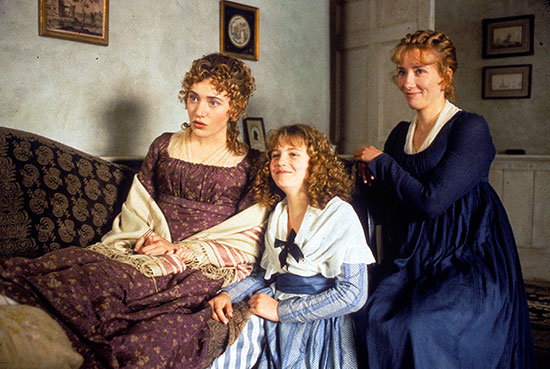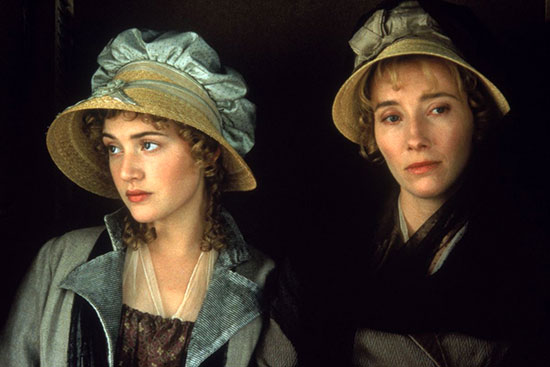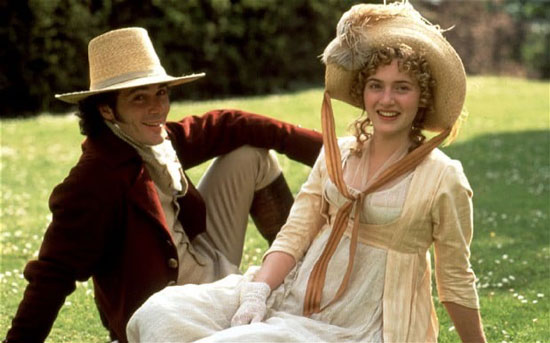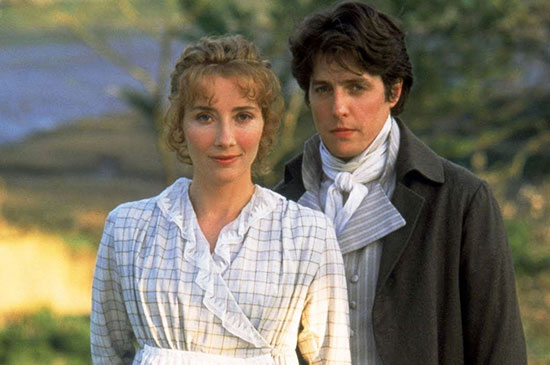Last Updated on February 26, 2022
Several television mini-series adaptations of Jane Austen’s beloved first novel exist, but “Sense and Sensibility” (1995) remains the only feature-length film of the classic. Led by the writing-directing duo of screenwriter Emma Thompson and Taiwanese director Ang Lee, the movie is a triumph due to its wit, charm, and astute social observations.

To help keep this site running: Willow and Thatch may receive a commission when you click on any of the links on our site and make a purchase after doing so.
Steeped in period realism through carefully constructed costumes and settings, and featuring unforgettable English countryside locations, “Sense and Sensibility” pays respectful homage to its source material while bringing a fresh and timeless vision of the novel to the screen.
Andreina Romero and Gabriela Mörken-Romero, hosts of the podcast Wigs and Candles, review classic and more recent period films, focusing in particular on the way period dramas provide a lens to explore the past and the lives of women through different historical times. In the third of a series of articles for Willow and Thatch, they review “Sense and Sensibility” (1995).
In the early 19th century, the lives of three British sisters are drastically altered after their father, Mr. Dashwood, dies. According to English law, Mr. Dashwood’s inheritance, including his house Norland Park, must be passed down to John Dashwood, his son from a previous marriage.
Mrs. Dashwood and her daughters, Elinor, Marianne, and Margaret, must leave their home and move to a more modest residence, Barton Cottage, and learn to live their lives as women of a lower social status.

“Sense and Sensibility” focuses primarily on the two eldest sisters, Elinor and Marianne; Elinor is played by then already veteran actor Emma Thompson, with a fresh-faced, pre-“Titanic” Kate Winslet taking on the role of Marianne. As in Jane Austen’s novel, the sisters are a study in opposing, but complementary, personalities. Elinor is restrained and sensible; Marianne is passionate and romantic, the “sensibility” to Elinor’s “sense.”
The film follows the Dashwoods as they adapt to their new reality, facing their futures amid the challenges and restrictions their situation brings. Top among all of their worries is the sisters’ marriage prospects, now seriously reduced. Worst of all for the Dashwood sisters: more than love or companionship, marriage now represents one of the few ways for them to avoid a life of poverty.
With the encouragement of the film’s producer Lindsay Doran, Emma Thompson crafted a screenplay that shines. Thompson, who went on to win an Oscar for best adapted screenplay during the 1996 Academy Awards, shared that one of her goals was to simplify the dialogue of the novel without losing any of Austen’s wit and elegance. Through the numerous rewrites (the initial version was reportedly 300 pages long), Thompson moved the focus slightly from the romantic relationships to the relationship between the sisters.
Perfectly calibrated between humor and drama, Thompson’s script provides sharp commentary on the status of women in early 19th century England, and the unfairness of a legal system that relegated women and girls to be fully dependent on the men in their lives. And as with any good Jane Austen adaptation, the discourse on class and status serves as a rich context for the love stories that form the core of the narrative.
Elinor, older and wiser than Marianne, barely dares to dream of love as she develops a sweet friendship with her sister-in-law’s brother, Edward Ferrars (Hugh Grant). Her hopes, faint as they are, are quickly thwarted by Fanny Ferrars (Harriet Walter), John Dashwood’s odious wife, who intercedes by sending Edward away when she realizes he may be falling in love with Elinor. For Fanny, Elinor’s status is insufficient for her brother and the Ferrars family.
Marianne is swept into an ardent fantasy when she meets the dashing John Willoughby (Greg Wise), who appears out of nowhere during a rainstorm to rescue an injured Marianne. Willoughby is everything Marianne has dreamed of: handsome, romantic (he carries a book of sonnets in his jacket for impromptu reads), and a full believer, as Marianne is, that life is to be lived with passion.

But both Elinor and Marianne’s dreams are soon dashed, and the heart of “Sense and Sensibility” comes into focus as it reveals how the contrasting characters confront heartbreak.
Marianne falls severely ill, and in stoic acceptance of her fate, Elinor continues to hold the family together. This dynamic leads to some of the most moving scenes in the movie, where the sisters, already loving, understanding, and supportive of each other, show their unconditional love for each other.
Throughout, Ang Lee’s subtle directing brings a lightness to the film, ambling between bucolic vistas of the English countryside, elegant interiors of Norland Park, and the more humble ones of Barton Cottage.
While the cinematography is evocative of early 19th century English paintings, Lee’s focus is on the characters: the stiff formality between the sexes when they meet, the warm ease that surrounds the Dashwood sisters and their mother, the interior lives of Elinor and Marianne when they are alone (Elinor is resigned; Marianne thoughtful but also restless and undeterred from living life to its fullest).
The result is that the movie feels lived-in, both through the exquisite set design and true-to-period costumes (by the award-winning team of Jenny Beavan and John Bright), and in the naturalistic performances by the main cast, in particular, by Emma Thompson as Elinor.

As Edward Ferrars, Hugh Grant bolsters the film’s humor with a classic bumbling, self-effacing performance. The great late Alan Rickman as Colonel Brandon, Marianne’s later love interest, rounds up the superb collection of English actors that lend their talent to the film.
Ang Lee and Emma Thompson make a classic love story come to life with freshness and authenticity. With fleshed out characters, intrigue, intersecting love stories, humor and intelligence, the movie offers an uncompromising adaptation of Austen’s portrayal of sisterly love. This is a film to watch and re-watch; “Sense and Sensibility” (1995) feels like a cozy blanket on a rainy late summer day.
Listen to the full Wigs and Candles podcast on “Sense and Sensibility” (1995) here.
“Sense and Sensibility” (1995) is AVAILABLE to STREAM
Rated PG
Our reviews of the “Sense and Sensibility” TV series adaptations, along with other movies and books to read if you love the classic, are here.
Wigs and Candles, launched in 2021, is a podcast about two sisters and their obsession with period film. Andreina Romero is a freelance writer and researcher whose work focuses on the importance of the arts in life. She also reviews books, music, and films in local publications and her personal blog. Gabriela Mörken-Romero leads people in a multinational company with a passion for art history, historical fiction, and world museums. Originally from Venezuela, Andreina and Gabriela host their podcast from Canada and Germany respectively.
If you enjoyed this post, wander over to The Period Films List. You’ll especially like the Best Period Dramas: Georgian and Regency Era list. Also see the Period Drama Lover’s Guide: Sense and Sensibility, and Sartorial Sense and Sensibility: Dressing Elinor and Marianne.

